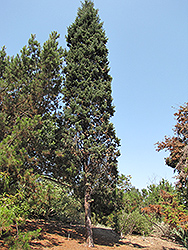It's all about ...
plants

Height: 50 feet
Spread: 30 feet
Sunlight:
![]()
Hardiness Zone: 9a
Description:
A pyramidal tree, becoming more rounded with age; foliage is scale sprays that are light to dark green; single trunked, or may divide at the base; native only to Guadalupe island of Mexico; use as a solitary accent tree in the landscape
Ornamental Features
Guadalupe Cypress is primarily valued in the landscape for its distinctively pyramidal habit of growth. It has attractive grayish green-variegated dark green foliage. The scale-like sprays of foliage are highly ornamental and remain dark green throughout the winter. The brown fruits which fade to gray over time are held in cones from mid fall to early winter. The peeling antique red bark adds an interesting dimension to the landscape.
Landscape Attributes
Guadalupe Cypress is a dense evergreen tree with a strong central leader and a distinctive and refined pyramidal form. It lends an extremely fine and delicate texture to the landscape composition which can make it a great accent feature on this basis alone.
This is a relatively low maintenance tree, and should not require much pruning, except when necessary, such as to remove dieback. Deer don't particularly care for this plant and will usually leave it alone in favor of tastier treats. It has no significant negative characteristics.
Guadalupe Cypress is recommended for the following landscape applications;
- Accent
- Shade
- Vertical Accent
Planting & Growing
Guadalupe Cypress will grow to be about 50 feet tall at maturity, with a spread of 30 feet. It has a low canopy with a typical clearance of 4 feet from the ground, and should not be planted underneath power lines. It grows at a medium rate, and under ideal conditions can be expected to live to a ripe old age of 100 years or more; think of this as a heritage tree for future generations!
This tree should only be grown in full sunlight. It prefers dry to average moisture levels with very well-drained soil, and will often die in standing water. It is considered to be drought-tolerant, and thus makes an ideal choice for xeriscaping or the moisture-conserving landscape. It is not particular as to soil pH, but grows best in sandy soils. It is somewhat tolerant of urban pollution. This species is not originally from North America.
This plant is not reliably hardy in our region, and certain restrictions may apply; contact the store for more information.

